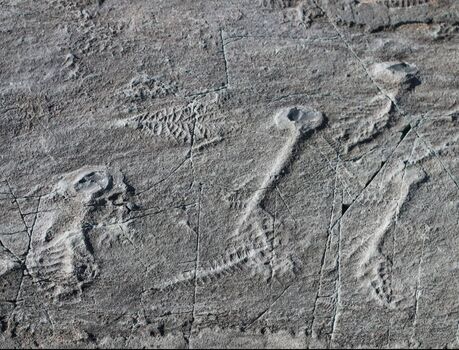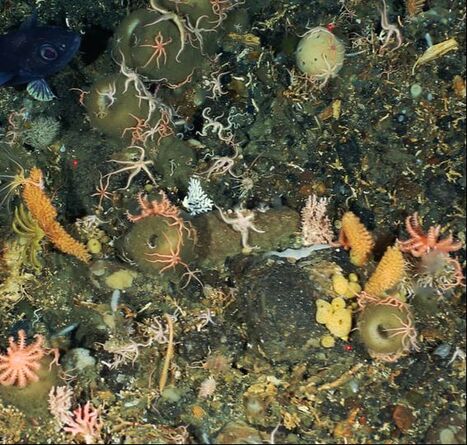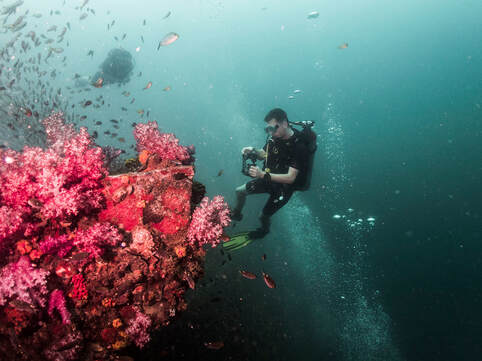Origins and evolution of animals

Animals first appear in the fossil record during the Ediacaran time period (631-541 million years ago). It is during the Ediacaran animals evolved some of their most important traits: most obviously large body-size but also tissue-differentiation, mobility, bilateral symmetry and ecosystem engineering (reef-building). The study of Ediacaran organisms is fraught with difficulties because commonly-used morphological approaches have only limited use due to the unique anatomies of Ediacaran organisms. Fortunately, the preservation of Ediacaran fossils is exceptional with thousands of immobile organisms preserved where they lived under volcanic ash. Therefore, the position of the fossil on the rock surface encapsulates their entire life history: how they reproduced and how they interacted with each other and their environment. As such, ecological statistics provides a novel approach for investigating fundamental issues in early animal evolution.
Ecology through deep-time

We are interested in the relationship between evolutionary innovations and ecosystem structure through deep-time. Using ecological network models we consider how the ecosystem structure and stability develop with the introduction of key animal traits, such as mobility, biomineralization and macro-predation. Working on fossil assemblages in the Cambrian, Silurian and Jurassic we are looking at how macro-ecological patterns are related to the evolution of different traits and animal groups impacts ecosystem structure.
Antarctic benthic Ecology

The ecological structure of modern Antarctic benthic marine communities is unique and differs from the rest of the world. It is dominated by epifaunal suspension feeders (including brachiopods, sponges and stalked crinoids) in shelf areas, with a paucity of shell crushing predators (sharks, rays, durophagous decapods). However, generally there is limited data on the Southern Hemisphere benthic ecosystems compared to other areas globally. Together with colleagues at British Antarctic Survey and Alfred Wegener Institute for Polar and Marine Research we are investigating the spatial structure of Antarctic communities on fine and large scales using newly developed methodologies for the analysis of community ecology. This will enable us to establish key species that underpin benthic community ecology, and the environmental factors that affect Vulnerable Marine Ecosystems (VMEs). This investigation will help quantify the potential future adverse effects of bottom fisheries and anthropogenic climate change on modern Antarctic benthic marine communities. Such information is essential to inform policy makers and develop future sustainable management plans for the region.
Photo credit: OFOBS at the Alfred Wegener Institute (AWI).
Photo credit: OFOBS at the Alfred Wegener Institute (AWI).
Shallow water benthic community development

A key area of our research is on the dynamics of modern marine benthic community dynamics, identifying the key ecological interactions that drive benthic biodiversity, and understanding how these drivers may change as ecosystems are perturbed both biologically and environmentally. Key to our approach is looking beyond interactions just between pairs of taxa, but understanding how the community interacts as a whole, and how changes cascade through the ecosystem and effect different organisms in different ways. Currently, we are working to understand how tropical benthic communities mature and how these systems are impacted and re-structured by sudden death events such as hurricanes. By reconstructing communities throughout the maturation processes, we aim to understand how ecological interactions differ throughout community development and thus elucidate how such dynamics contribute to community structure, resilience and stability. We are currently developing our underwater data collection techniques resulting in the creation of 3D models of tropical benthic communities e.g. Reef.
Life in the Universe

We are not only interested in evolution of life on Earth, but also the origins of life and how life may evolve elsewhere in the Universe. Working with colleagues in the Leverhulme Centre of Life in the Universe we are interested in understanding how we could detect life on other planets, and how different phases of biosphere complexity and evolution would be reflected in these biosignatures. We can use the timeline of life on Earth to make predictions for each habitable exoplanet about what sort of biosphere evolutionary phase we expect it to be in, and therefore what biosignature it should have. The detection of life elsewhere in the Universe has the potential to address fundamental questions in evolutionary biology, such as the inevitability of life, complex life and intelligent life. How much of life’s rich tapestry falls out of null evolutionary models, and is a mere consequence of the first life, or is something more needed to make these big evolutionary innovations occur?